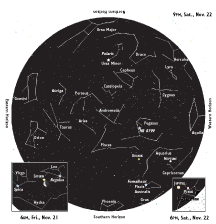
|
Volume 16, Issue 47 - November 20 - November 26, 2008
|
|
Columns |
 |
Sky Watch by J. Alex Knoll
Planets Near and Far
Astronomers claim to have finally seen planets beyond our own solar system
The waning crescent moon crests the eastern horizon around 1am Friday, followed close behind by golden Saturn. About 20 degrees higher and shines the first-magnitude star Regulus, the heart of the celestial lion Leo. The brighter star Spica rises a few hours after the moon and Saturn, which easily outshines any star. As dawn approaches around 6am, Saturn and the moon hover high in the southeast with little more than five degrees separating the two.
Venus and Jupiter are less than 10 degrees apart at week’s end in the early evening sky. They draw together by one degree each evening on the way to an end-of-month conjunction less than two degrees apart.
For more than a decade now, astronomers have used powerful telescopes and computers to identify planets outside of our own solar system — called exo-planets — based on the slight tug of these orbiting planets on their parent star. However, these exo-planets have all greatly out-sized Jupiter and orbited their suns farther than Pluto orbits our own.
Now, within the past few weeks, two different teams have announced that they have spotted exo-planets crossing in front of their parent stars.
Using images collected from the Hubble Space Telescope over several years, a team from the University of California, Berkeley isolated a pinpoint of light crossing the star Fomalhaut, in the constellation Piscis Australis. Using the Keck II and Gemini telescopes in Hawaii, a Canadian team has isolated infrared images of what they claim are three planets orbiting the star HR 8799 in the constellation Pegasus.